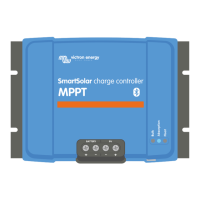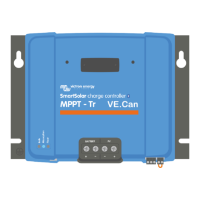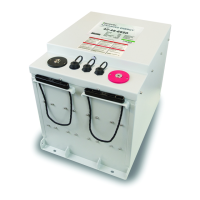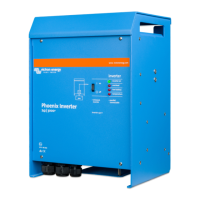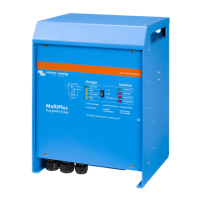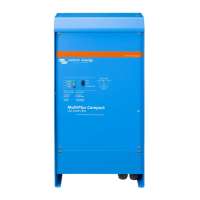Do you have a question about the Victron energy MPPT and is the answer not in the manual?
Important safety instructions for installation, operation, and maintenance.
Guidelines for using flexible multi-stranded copper cable for connections.
Details maximum PV voltage and battery charge current for models.
Describes the two available PV terminal types: screw terminals (TR) and MC4.
Charger automatically detects system voltage on first power-up.
Features ultra-fast MPPT tracking for optimal solar yield.
Achieves high efficiency, up to 98%, with no cooling fan.
Includes over-temperature, reverse polarity, and reverse current protection.
App for monitoring, operation, data access, settings, and firmware updates.
Lists display options including the VictronConnect App.
Port for communication with monitoring devices and VictronConnect App.
Ports for communication with monitoring devices like GX devices.
Describes the Bulk, Absorption, and Float charge stages.
Allows selection of 8 pre-set or programmable charge algorithms.
Periodic charge to balance cells and prevent stratification.
Allows temperature-compensated charging using internal or external sensors.
Uses the built-in sensor for temperature compensation estimation.
Uses Smart Battery Sense for accurate measurements.
Optional sensor for measuring battery terminal voltage.
Terminal for remote control of the charger.
Relay can be programmed to engage based on specific conditions.
Optional plastic cover for battery and solar terminals for added safety.
Instructions for vertically mounting the solar charger.
Requirements for battery fuse protection and cable selection.
Guidelines for PV array configuration and voltage/current ratings.
Details chassis, PV array, and ground fault detection grounding.
Step-by-step order for making electrical connections.
Instructions for installing the external SmartSolar Control display.
Instructions for connecting the optional MPPT Control display.
Overview of methods to change charger settings.
Using the VictronConnect App to change settings and update firmware.
Using the rotary switch to select pre-programmed battery charge algorithms.
Configuring settings using the SmartSolar Control display.
Configuring settings using the MPPT Control display.
Explains configurable settings and firmware updates.
Details battery voltage, max charge current, and battery presets.
Settings for controlling the load output based on battery voltage.
Configuring the programmable relay for various conditions.
Function to automatically control night lighting with timer programs.
Functionality of the TX port for sending signals.
Functionality of the RX port for receiving signals.
Procedure for checking and updating firmware via VictronConnect.
How to disable or enable Bluetooth via VictronConnect.
Enables products to share data wirelessly via Bluetooth.
Steps to set up a new VE.Smart network.
Describes the charger powering up and communication.
Explains how the charge controller starts a new cycle.
How absorption time is determined for lead-acid batteries.
Discusses pausing absorption time and restarting the process.
Explains how automatic equalization works and its settings.
Recommended settings for Lithium Iron Phosphate (LiFePO4) batteries.
Steps for safely shutting down and restarting the charger.
Notes that the solar charger does not require regular maintenance.
Explains the meaning of the blue, green, and yellow LEDs for status and errors.
How error codes are displayed and where to find a full list.
Using the app to monitor live data, history, and errors.
Displays charger model and live information.
Shows a summary of data collected over the previous 30 days.
Indicates active and historical errors within the app.
Accessing data and alarms via GX device or VRM portal.
Checks for power-up issues and basic visual inspection.
Inspects for mechanical damage, burn marks, or water damage.
Verifies battery voltage at terminals using a multimeter.
Lists reasons why batteries may not be charging.
Explains issues with accidental swapping of battery cables.
Discusses PV input protection against reverse polarity.
Explains when the charger stops charging due to a full battery.
Troubleshooting for missing remote connector or external control.
Checks if the charger is enabled in VictronConnect settings.
Explains conditions for charging to commence based on PV voltage.
Verifies if the battery voltage setting matches the system.
Discusses external control affecting charger operation.
Diagnoses problems related to battery connection and supply.
Addresses issues where PV voltage exceeds the charger's limit.
Lists signs and causes of undercharged batteries.
Explains how system loads affect battery charging.
Checks if battery voltage settings are too low.
Discusses reduced charge current when the battery is nearly full.
Explains voltage drop in battery cables affecting charging.
Importance of equal ambient temperatures for accurate charging.
Reasons for not reaching float charge stage, like not enough panels.
Incorrect settings leading to under or overcharging.
Checks if the max charge current setting is too low.
Risks and causes of overcharging batteries.
Overcharging due to incorrect battery voltage settings.
Overcharging caused by excessively high charge voltages.
Overcharging risk if battery cannot handle equalization.
Issues with old or faulty batteries leading to overcharging.
Potential solar-related issues not covered previously.
Addresses damage from excessive current or reverse polarity.
Investigating lower than expected solar power generation.
Reasons for not achieving the full rated output, e.g., small PV array.
How battery voltage affects output power.
Recommendation against mixing PV panel types.
Causes of burned or melted PV connections.
Guidance on correctly connecting MC4 connectors.
Warning against using solar panels with optimisers.
Notes the absence of internal earth fault detection.
Investigating ground current and system grounding.
Issues arising from connecting to apps or other devices.
General troubleshooting for the VictronConnect app.
Troubleshooting VE.Direct port communication problems.
Troubleshooting VE.Can port communication issues.
Troubleshooting issues with VE.Smart Network communication.
Common causes and troubleshooting for Bluetooth issues.
Resolving issues related to incorrect settings or firmware.
Advice on checking and resetting configuration settings.
Steps to update firmware and resolve potential bugs.
Guidance on recovering from interrupted firmware updates.
Troubleshooting for issues not covered in previous chapters.
Discourages use as a power supply without batteries.
Discourages use as a DC to DC charger.
Troubleshooting relay functionality and contact protection.
Technical data for 150/70, 150/85, and 150/100 models.
Technical data for 250/70, 250/85, and 250/100 models.
Detailed dimensional drawings for the 70A-MC4-VE.Can model.
Detailed dimensional drawings for the 70A-Tr-VE.Can model.
Dimensional drawings for 85A and 100A MC4 VE.Can models.
Dimensional drawings for 85A and 100A Tr VE.Can models.
Lists possible error codes and their meanings.
| Brand | Victron energy |
|---|---|
| Model | MPPT |
| Category | Battery Charger |
| Language | English |
